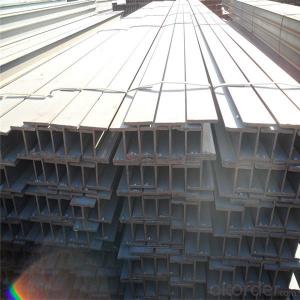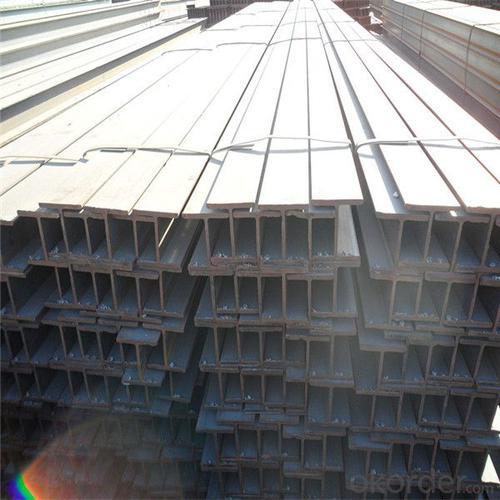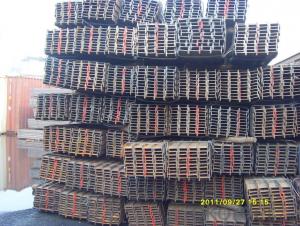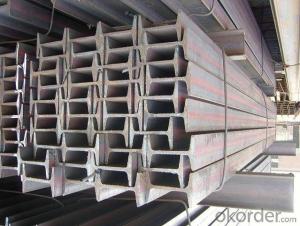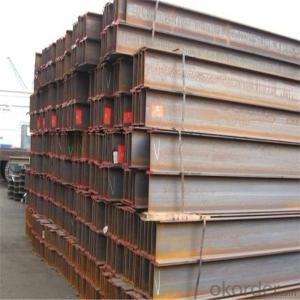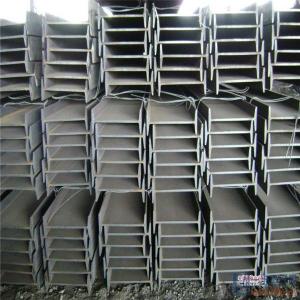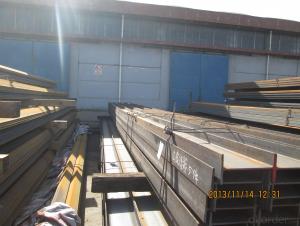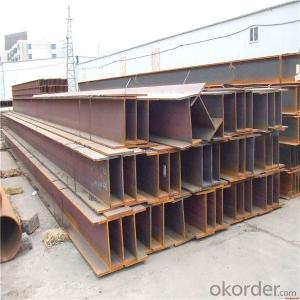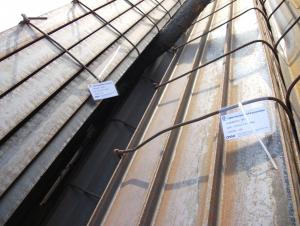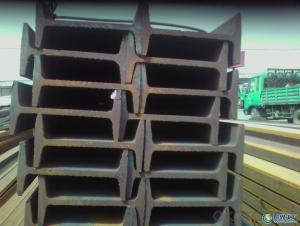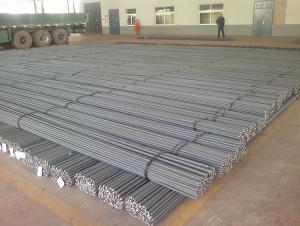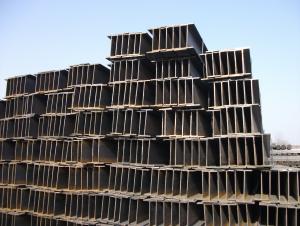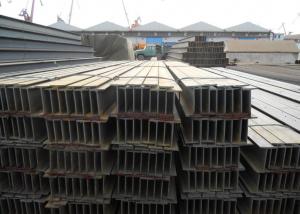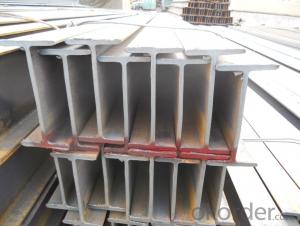Wide Flange H-Steel Beams Steel with Full Size
- Loading Port:
- Dalian
- Payment Terms:
- TT OR LC
- Min Order Qty:
- 120 m.t
- Supply Capability:
- 150000 m.t/month
OKorder Service Pledge
OKorder Financial Service
You Might Also Like
Specification
Quick Detail
Place of Origin: | Tianjin, China (Mainland) | Grade: | Q235B | Technique: | High Frequency |
Application: | Building construction,Bridge construction etc. | Length: | 6.0meters,9meters,12meters | Standard: | ASTM |
Flange Width: | 100-750mm | Flange Thickness: | 3.0-10.0mm | Web Width: | 50-250mm |
Web Thickness: | 2.3-8.0mm | Brand Name: | Liye |
We can provide qualify goods,competitive price and speedy delivery.
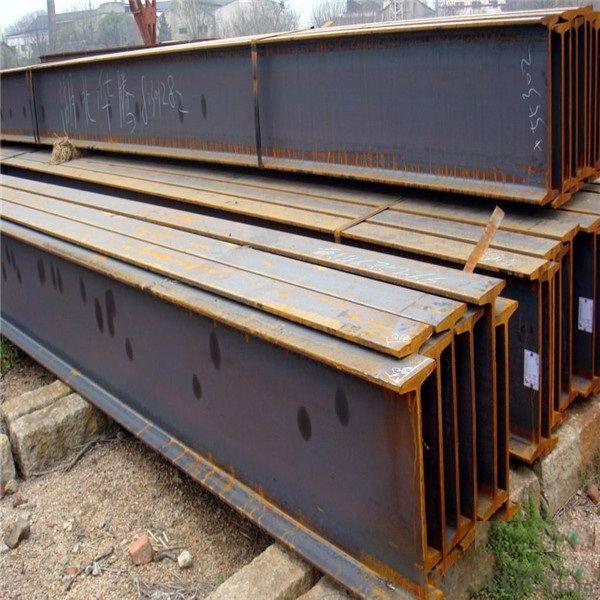
Products Description
H Type Steel Size and Theoretical Weight | |||||
Size | Theoretical Weight | Size | Theoretical Weight | Size | Theoretical Weight |
|
|
|
|
|
|
(mm) | (kg/m) | (mm) | (kg/m) | (mm) | (kg/m) |
100*50*5*7 | 9.3 | 250*125*6*9 | 29 | 446*199*8*12 | 65.1 |
100*100*6*8 | 16.9 | 250*250*9*14 | 71.8 | 450*200*9*14 | 74.9 |
125*60*6*8 | 13.1 | 294*200*8*12 | 55.8 | 482*300*11*15 | 110.8 |
125*125*6.5*9 | 23.6 | 298*149*5.5*8 | 32 | 488*300*11*18 | 124.9 |
148*100*6*9 | 31.1 | 340*250*9*14 | 36.7 | 496*199*9*14 | 77.9 |
150*75*5*7 | 14 | 300*150*6.5*9 | 93 | 500*200*10*16 | 88.1 |
150*150*7*10 | 20.7 | 300*300*10*15 | 78.1 | 582*300*12*17 | 132.8 |
175*90*5*8 | 18 | 346*174*6*9 | 41.2 | 588*300*12*20 | 147 |
175*175*7.5*11 | 40.4 | 350*175*7*11 | 49.4 | 596*199*10*15 | 92.4 |
194*150*6*9 | 29.9 | 350*350*12*19 | 134.9 | 600*200*11*17 | 103.4 |
198*99*4.5*7 | 17.8 | 390*300*10*16 | 104.6 | 700*300*13*24 | 181.8 |
200*100*5.5*8 | 20.9 | 396*199*7*11 | 56.1 | 800*300*14*26 | 206.8 |
200*200*8*12 | 49.9 | 400*200*8*13 | 65.4 | 900*300*16*28 | 240.1 |
244*175*7*11 | 43.6 | 400*400*13*21 | 171.7 |
|
|
248*124*5*8 | 25.1 | 440*300*11*18 | 120.8 |
|
|
Length=6------12meters | |||||
Packaging & Delivery
Packaging Details: | Packed with waterproof paper and steel banding. |
Delivery Detail: | 15-25 |
FAQ
1. How can I get some samples?
We are honored to offer you samples. New clients are expected to pay for the courier cost. The samples are free for you.
2 Do you have any certificates?
Our products passed inspection of SGS, FDA, and CE Quality is priority! Every worker keeps the QC from the very beginning to the very end, Quality control department especially responsible for quality checking in each process.
3 Can your factory print or emboss my logo on the goods?
Yes, we can print or emboss the logo on the goods or their packing box.
4 What information should I let you know if I want to get a quotation?
1) The specification of products (length x width x thickness);
2) The temper and alloy.
3) The final product you will use to be made
4 It will be better if you can show us the pictures or design sketch. Samples will be best for clarifying. If not, we will recommend relevant products with details for reference.We usually produce goods based on customers
Samples or based on customers’ picture, logo, sizes etc.
- Q: How do steel H-beams perform in coastal areas?
- When constructing in coastal areas, steel H-beams are often chosen due to their durability and reliability. The coastal environment poses challenges like high humidity, exposure to saltwater, and strong winds, which can hasten corrosion and structural degradation. Nevertheless, steel H-beams are specifically engineered to withstand these conditions. One of the main advantages of steel H-beams in coastal areas is their exceptional resistance to corrosion. Most steel H-beams are manufactured using carbon steel and are coated with protective materials like galvanization or epoxy paint. These coatings create a barrier that prevents moisture and saltwater from reaching the steel and causing corrosion. Additionally, the structural design of H-beams, with their wide flanges and deep web, offers remarkable strength and stability against wind and waves. Furthermore, steel H-beams have a lengthy lifespan and require minimal maintenance in coastal areas. The protective coatings, combined with the inherent strength of steel, ensure that these beams can endure the harsh coastal environment for many years without significant deterioration. Regular inspection and maintenance of the coatings can further extend their lifespan. However, it is important to acknowledge that the performance of steel H-beams in coastal areas can be influenced by various factors. The precise location, proximity to the shoreline, exposure to salt spray, and prevailing wind conditions can all impact the performance and longevity of steel H-beams. Therefore, it is crucial to consult with structural engineers and adhere to proper design and construction practices to guarantee optimal performance of steel H-beams in coastal areas.
- Q: What are the common sizes of steel H-beams?
- The size of steel H-beams commonly varies based on the specific requirements and needs of a project. Nonetheless, construction and engineering applications usually utilize standard sizes. A few frequently used sizes are as follows: - W6x9: This size corresponds to a wide flange beam with a 6-inch height and a weight of 9 pounds per foot. It finds application in residential construction or smaller structural projects. - W10x33: Another commonly employed size, this wide flange beam has a height of 10 inches and weighs 33 pounds per foot. It is prevalent in commercial construction and larger structural undertakings. - W12x65: This wide flange beam measures 12 inches in height and weighs 65 pounds per foot. It is commonly used in heavy-duty construction or for supporting heavier loads. - W18x76: With a height of 18 inches and a weight of 76 pounds per foot, this wide flange beam is often employed in industrial settings or for supporting extremely heavy loads. - W36x135: One of the largest readily available sizes of wide flange beams, this beam stands at 36 inches in height and weighs 135 pounds per foot. It is typically utilized in the construction of large-scale structures like bridges or high-rise buildings. These examples provide a glimpse into the common sizes of steel H-beams. To determine the appropriate size for a specific project, it is crucial to consult a structural engineer or refer to industry standards. Factors such as load capacity, span length, and structural design can influence the size requirements.
- Q: How do steel H-beams perform in high-traffic areas such as airports or train stations?
- Steel H-beams are an ideal choice for high-traffic areas such as airports or train stations due to their exceptional performance characteristics. Firstly, steel H-beams offer superior structural strength and stability, which is crucial in areas with heavy foot traffic and constant movement of vehicles. They can support heavy loads without bending or warping, ensuring the safety and longevity of the structure. Moreover, steel H-beams have excellent resistance to wear and tear. In high-traffic areas, frequent contact with luggage carts, trolleys, and other heavy equipment can cause significant damage to the infrastructure. However, steel H-beams are highly durable and can withstand this constant impact without compromising their structural integrity. Additionally, steel H-beams are known for their fire resistance. Airports and train stations are public spaces where fire safety is of utmost importance. Steel is a non-combustible material, and H-beams have a high melting point, which means they have a better chance of withstanding fire accidents and minimizing the spread of flames, providing added safety for occupants. Furthermore, steel H-beams are highly customizable, allowing for efficient design and construction in high-traffic areas. They can be fabricated to various lengths, sizes, and shapes, ensuring the structural requirements of the specific location are met. This versatility enables architects and engineers to create innovative and efficient designs that optimize space and accommodate the needs of the area. In terms of maintenance, steel H-beams have a low maintenance requirement, making them cost-effective in the long run. With regular inspections and minimal repairs, steel H-beams can maintain their structural integrity and appearance for many years, even in high-traffic areas. Overall, steel H-beams are the preferred choice for high-traffic areas such as airports or train stations due to their exceptional strength, durability, fire resistance, and customization options. Their performance characteristics make them capable of withstanding heavy loads, resisting wear and tear, and ensuring the safety and longevity of the infrastructure in these bustling public spaces.
- Q: What is the maximum load capacity of steel H-beams?
- The maximum load capacity of steel H-beams can vary depending on various factors such as the size, shape, and grade of the beam, as well as the span and support conditions of the specific application. Steel H-beams are designed to withstand heavy loads and are commonly used in construction and structural engineering projects. It is essential to consult engineering professionals or refer to structural design guidelines and load tables provided by manufacturers to determine the specific maximum load capacity for a given steel H-beam.
- Q: What are the different types of connections used for steel H-beams in multi-story buildings?
- There are several types of connections used for steel H-beams in multi-story buildings, each designed to provide structural integrity and stability. Here are some common types: 1. Welded connections: Welding is a widely used method to connect steel H-beams. It involves joining the beams by melting the metal at the connection point and allowing it to solidify. Welded connections provide excellent strength and rigidity. 2. Bolted connections: Bolted connections involve using bolts, nuts, and washers to fasten the steel H-beams together. This type of connection is convenient for assembly and disassembly, making it suitable for prefabricated construction. Bolted connections can be easily adjusted or replaced if needed. 3. Riveted connections: Riveting is an older method of connecting steel H-beams. It involves using high-strength steel bolts called rivets to join the beams. Riveted connections were commonly used in the past but are less prevalent today due to the labor-intensive nature of the process. 4. Moment connections: Moment connections are designed to transfer both vertical and horizontal loads between steel H-beams. They provide rotational resistance by using plates, angles, and bolts to create a rigid connection. Moment connections are commonly used in high-rise buildings to ensure structural stability. 5. Shear connections: Shear connections are used to transfer horizontal loads between steel H-beams. They typically involve using steel angles, plates, or channels to connect and transfer shear forces. Shear connections are crucial in resisting lateral forces such as wind or seismic loads. It is important to note that the specific type of connection used for steel H-beams in multi-story buildings may vary depending on factors such as building design, load requirements, and construction methods. Structural engineers carefully select the appropriate connection type to ensure the safety and stability of the structure.
- Q: What are the common design mistakes to avoid when using steel H-beams?
- When using steel H-beams in design, there are several common mistakes that should be avoided to ensure structural integrity and safety. These mistakes include: 1. Inadequate beam sizing: One common mistake is selecting an H-beam size that is too small for the intended load. This can result in structural failure or excessive deflection. It is crucial to accurately calculate the required beam size based on the expected loads and consult structural engineering guidelines or professionals for proper sizing. 2. Incorrect placement of beams: Ensure that H-beams are properly placed and aligned. Misalignment or incorrect spacing can compromise the load-bearing capacity and stability of the structure. It is important to follow the structural design plans and guidelines to ensure correct placement. 3. Insufficient connection strength: Another mistake is using improper or inadequate connections between H-beams and other structural elements. Inadequate connection strength can lead to failure or inadequate load transfer. Proper connection design, such as welding or bolted connections, should be employed to ensure structural integrity. 4. Lack of bracing: Failing to provide sufficient bracing for H-beams can result in excessive deflection and instability. Bracing helps to resist lateral loads and prevent buckling of the beams. It is important to carefully consider the bracing requirements and incorporate them into the design to ensure stability. 5. Neglecting corrosion protection: Steel H-beams are susceptible to corrosion, especially in environments with high moisture or aggressive chemicals. Neglecting proper corrosion protection measures can lead to premature deterioration and compromise the structural integrity of the beams. Coatings, such as paint or galvanization, should be applied to protect the steel from corrosion. 6. Ignoring thermal expansion: Steel H-beams can expand and contract with temperature changes. Ignoring the thermal expansion and not providing sufficient allowances for movement can result in stress accumulation and potential failure. Proper consideration of thermal expansion and contraction should be incorporated into the design to prevent structural problems. To avoid these common design mistakes, it is crucial to consult structural engineering guidelines, codes, and professionals, who can provide accurate calculations, proper sizing, and guidance for the specific project requirements.
- Q: Can steel H-beams be used in museums and art galleries?
- Yes, steel H-beams can be used in museums and art galleries. They are commonly utilized for structural support in large spaces and can provide stability and durability needed in these settings. Additionally, their sleek and minimalist design can complement various architectural styles and accommodate the display of artwork and exhibits effectively.
- Q: Can steel H-beams be used for supporting cantilever structures?
- Yes, steel H-beams can be used for supporting cantilever structures. The H-beams provide excellent load-bearing capabilities and stability, making them suitable for supporting structures that extend beyond their support point.
- Q: Can steel H-beams be used for overhead crane systems?
- Yes, steel H-beams can be used for overhead crane systems. H-beams are commonly used as structural supports in construction and industrial applications, including overhead crane systems. Their strong and durable nature makes them well-suited for supporting the weight of cranes and the loads they carry.
- Q: Can steel H-beams be used for industrial warehouses?
- Industrial warehouses can definitely utilize steel H-beams. These beams are commonly employed in constructing such structures because of their exceptional strength, durability, and versatility. H-beams are highly capable of supporting heavy loads, which makes them perfect for large-scale buildings like warehouses that often house heavy equipment and storage goods. In addition, steel H-beams are resistant to fire, pests, and natural elements, ensuring the safety and long-term durability of the warehouse. They also offer flexibility in design, enabling architects and engineers to create spacious and open layouts. In conclusion, steel H-beams are a great choice for industrial warehouses due to their strength, durability, and ability to adapt to diverse construction requirements.
Send your message to us
Wide Flange H-Steel Beams Steel with Full Size
- Loading Port:
- Dalian
- Payment Terms:
- TT OR LC
- Min Order Qty:
- 120 m.t
- Supply Capability:
- 150000 m.t/month
OKorder Service Pledge
OKorder Financial Service
Similar products
Hot products
Hot Searches
Related keywords
